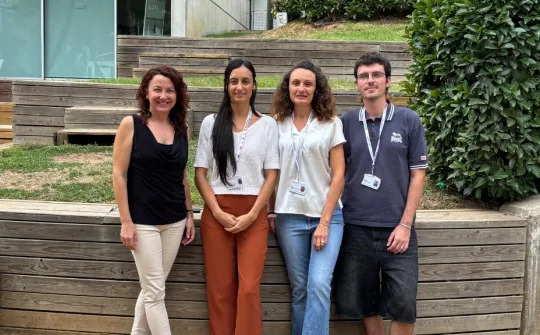‘Surgery and chemotherapy is like selectively pruning the tumor; targeted therapy, however, allows us to get to the root of the problem’

Jaume Mora, Scientific Director of the SJD Pediatric Cancer Center Barcelona shares what is in store for pediatric cancer healthcare in the future.
Jaume Mora, Scientific Director of the SJD Pediatric Cancer Center Barcelona and Head of the Sarcomas and Neuroblastoma Group at the SJD Research Institute, is the only Spanish researcher to have been awarded two prestigious FERO grants. In 2009, he was awarded the first grant that the foundation was offering to young researchers. Sixteen years later, he has been awarded the IV Dr Baselga Grant for consolidated researchers.
Mora has been a staunch supporter of dedicated facilities for treatment and research in pediatric oncology for years. He says, ‘pediatric cancer is nothing like adult cancer’. ‘Pediatric cancers originate in the fetal stage,’ he highlights. ‘All children that develop pediatric cancer are born with those genetic abnormalities, already with those preneoplastic cells that become cancerous at some point or another during postnatal growth, based on the growth of the affected organ. It has taken us 20 years to do so, but now it is more than proven. This fact makes more targeted research into pediatric cancer essential and justifies the existence of facilities like the SJD Pediatric Cancer Center Barcelona.’
What is the current state of pediatric cancer research?
We now know that pediatric cancers are due to genetic mutations in embryonic stem cells. We also know the cellular conditions in which the embryonic stem cells are when the differentiation process is stopped or blocked by the initial mutation. And this is very significant because it means we now have the option of reversing this block, and, by doing so, stopping the growth of the tumor in a targeted, non-toxic way. We are not trying to destroy these stem cells, but rather unblock them so that they can continue with their normal differentiation process.
How do you do that?
Right now, when a patient arrives with a very large tumor, we surgically remove it and administer chemotherapy and radiotherapy to destroy any visible tumor cells. But we want to go beyond this, attacking the root of the problem, acting on the stem cells that are able to create new cancerous cells and repopulate the tumor (relapse). Let’s think of it this way: surgery and chemotherapy is like selectively pruning the tumor, but targeted therapy allows us to get to the root of the problem, acting on stem cells to stop the tumor from growing again. We can do this in two ways: with immunotherapy, activating the immune system; or with targeted therapy, administering drugs that unblock the stem cell so that it can continue along its usual course.
On which tumors is it effective?
Immunotherapy has been proven effective on some types of leukemia, neuroblastomas and lymphomas, but it cannot be used for all tumors, like sarcomas. We feel that targeted therapy will be especially useful for sarcoma cases, like rhabdomyosarcoma, for example.
You have just been awarded the IV Dr Baselga FERO Grant for consolidated researchers, with a total fund of 300,000 Euros, for research into rhabdomyosarcoma.
Rhabdomyosarcomas are treated today just like they were 30 years ago, and we manage to cure around 70% of cases. But a large percentage of patients whose disease metastasises or who relapse die.
There have been several attempts by various research teams, but nothing has ever worked. Now, thanks to the work of our group, we know that the PRKG1 protein plays a key role in the development of this tumor because it blocks the muscle lineage differentiation process that the stem cell has to follow. PRKG1 is a kinase-type enzyme that can be inhibited with drugs, thereby reestablishing the differentiation process. Now that we know about the blocking mechanism, we want to develop a PRKG1-specific inhibitor and lay the groundwork for the first guided clinical trial on PRKG1 in rhabdomyosarcoma.
Families have played a key role in researching this tumor. It was only thanks to the donation from Cristina's family—a young patient who sadly died—that this research project was possible.
All of the discoveries we have made at the hospital, all of them, in one way or another, have been possible thanks to the support of families. When it comes to rhabdomyosarcoma, it is a real game changer. We started this line of research into this tumor thanks to the resolve of Cristina's family. We started from nothing and have learned so much about the biology behind these tumors. Finally, we have made this discovery thanks to the skill and talent of Estela Prada, first author of the study. And now we can continue to work on it thanks to the Fero grant. Nowadays we receive many prizes and recognition, but the families really were that initial push that got us to where we are today. It has been the case with rhabdomyosarcoma, but also with retinoblastoma, neuroblastoma, DIPG, Ewing sarcoma, and many others.
What does the future of pediatric cancer look like to you?
People are starting to talk more and more openly about prevention. Experts from around the world are starting to think of mass prevention measures for the whole population, with the possibility of neonatal screening, for example, to help prevent those infants born with a pretumoral clone from developing the tumor (leukemia, medulloblastoma, DIPG or Ewing sarcoma, etc.).
In Texas, one researcher is starting a neonatal program that involves brain MRIs because the medulloblastoma—a malignant brain tumor most prevalent in pediatric groups—is caused by an abnormality that occurs in a very specific part of the brain that can be treated early on with targeted therapy or through surgery.
All of this represents a very substantial paradigm shift. We will see which cases it can be applied to and to which it cannot, because some cases may not be suitable. That said, the future is bright.



